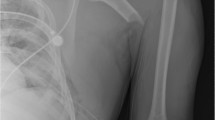Summary.
Posterior dislocation fracture of the shoulder is a rare injury that often occurs in association with a grand mal seizure. Our aim with this paper is to emphasize diagnosis and therapy. In the past 5 years seven patients with nine posterior dislocation fractures were treated operatively. In six patients a grand mal seizure was the cause of the injury and in one a direct trauma. Three four-part fractures were found in two patients and six locked posterior dislocation fractures in five patients. Clinical examination in locked posterior dislocation fractures showed a lack of external rotation, and flexion was performed by movement of the scapula. Radiological examination demonstrated an overlapping of the contours of the humeral head and the glenoid and the “trough line”. The operations were performed in the time between 4 h and 10 days later. Two of the three four-part fractures (in one patient) were treated with hemiarthroplaties, and one was fixed with screws. Closed reduction was attemted in six shoulders but was possible only in one patient. In this patient a redislocation occurred 3 days later and a combined anterior and posterior approach was done. A fracture of the anatomical neck was produced in another shoulder. Six open reductions and stabilizations with screws were performed, and three times we fixed the subscapular tendon in the reversed Hill-Sachs lesion with anchor sutures. Patients after grand mal seizures may have a posterior shoulder dislocation, and clinical and radiological examination should be emphasized. In locked posterior dislocation we favour early open reduction, fixation of the subscapular tendon with anchor sutures in the reversed Hill-Sachs lesion and stabilization of the lesser tuberosity with screws.
Zusammenfassung.
Die hintere Luxationsfraktur der Schulter ist eine seltene Verletzung, bei der die Symptomatik eines Krampfanfalls oft im Vordergrund steht. Ziel dieser Kasuistik ist es daher, Kriterien zur Diagnostik und Therapie aufzuzeigen. In den letzten 5 Jahren behandelten wir 7 Patienten, wobei 2 mal beidseitige Luxationsfrakturen auftraten. Bei 6 Patienten war die Erstmanifestation eines Krampfanfalls die Ursache. Einmal fand sich eine Viersegmentfraktur nach einem Direkttrauma, bei dem Kopf und Schulter eingeklemmt wurden. Ein Patient erlitt beidseitige Viersegmentfrakturen. Die übrigen 5 zeigten 6 dorsal verhakte Luxationsfrakturen, wobei das Tuberculum minus frakturiert war. Klinisch fanden wir bei den dorsal verhakten Frakturen eine aufgehobene Außenrotation und fehlende Abduktion im Schultergelenk. Schon in der a.-p.-Aufnahme zeigten sich eine Überlappung der Oberarmkopf- und Glenoidkonturen und das Mulden-Zeichen. Die operative Therapie erfolgte innerhalb von 4 Std bis 10 Tagen. Bei beidseitigen Viersegmentfrakturen erfolgte die prothetische Versorgung und bei einer mittels Verschraubung. Einmal wurde ein kombinierter dorsaler und ventraler Zugang wegen Redislokation nach 3 Tagen gewählt. Eine Fraktur im Collum anatomicum war die Folge eines geschlossenen Repositionsversuchs. Die übrigen 4 verhakten Luxationen wurden nach einem geschlossenen Repositionsversuch offen reponiert, die Tuberculum-minus-Frakturen wurden verschraubt und 3 mal erfolgte das Einnähen der Subskapularissehne in die verkehrte Hill-Sachs-Läsion mit Ankernähten.
Similar content being viewed by others
Author information
Authors and Affiliations
Rights and permissions
About this article
Cite this article
Schweighofer, F., Schippinger, G. & Peicha, G. Die hintere Luxationsfraktur der Schulter. Chirurg 67, 1251–1254 (1996). https://doi.org/10.1007/s001040050134
Issue Date:
DOI: https://doi.org/10.1007/s001040050134




